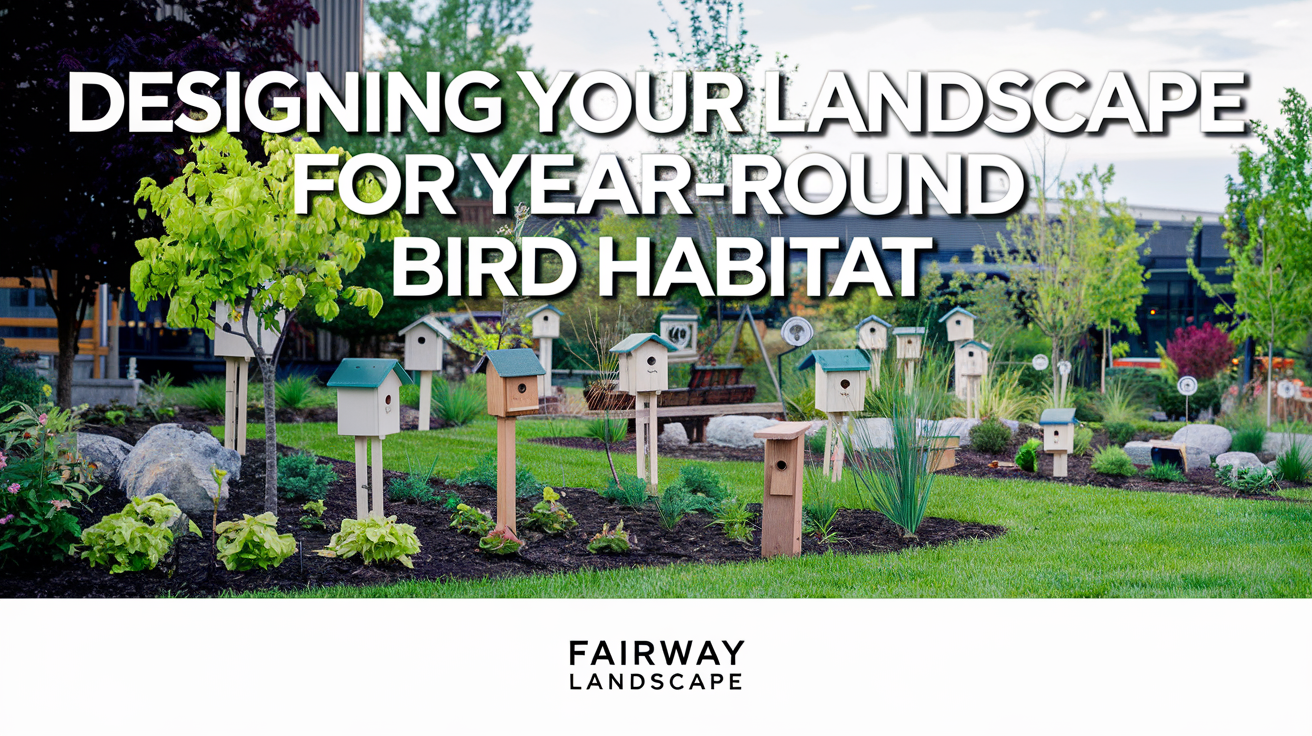The stark winter landscape outside your window might seem quiet and lifeless, but for many Maryland bird species, your yard represents critical habitat during these challenging months. While casual bird feeding provides important supplemental nutrition, truly bird-friendly landscapes offer comprehensive support through thoughtful design and plant selection. Creating these habitats not only supports local wildlife but adds dimension to your landscape experience—bringing movement, color, and song to your property throughout the year. With thoughtful planning now, you can enhance your landscape’s bird-supporting capabilities for all seasons.

Understanding Birds’ Year-Round Habitat Needs
Food resources must extend beyond feeders. While supplemental feeding helps many species, natural food sources provide essential nutrition diversity. Berry-producing shrubs, seed-bearing perennials, and insect-supporting plants create a complete nutritional landscape. Our native plant bird garden designs incorporate species that provide sequential food resources throughout the year.
Water availability dramatically influences bird presence. From drinking to bathing, birds require reliable water sources—particularly during winter when natural options may be frozen. Our bird-friendly landscape design includes appropriate water features with consideration for depth, accessibility, and year-round function.
Shelter requirements vary by species and season. Different birds utilize different structural layers within your landscape—from canopy trees to understory shrubs to ground cover. Comprehensive habitat provides options for nesting, roosting, and protection from predators and weather. Our habitat-focused designs create this essential vertical diversity.
Winter Habitat Enhancement Strategies
Evergreen structure provides critical winter shelter. Dense conifers like eastern red cedar, American holly, and white pine offer wind protection and predator concealment during winter’s harshest conditions. Our bird habitat designs strategically place these evergreens to create protected microclimates throughout your property.
Persistent fruits offer essential winter nutrition. While many landscape plants produce summer berries, fewer provide fruits that persist into winter when natural food is scarce. Our specialized plant selections include winterberry holly, chokeberry, and American beautyberry that hold their fruits through winter months, providing critical nutrition during food scarcity.
Brush piles create valuable microhabitats. Strategically placed brush accumulations provide shelter, foraging opportunities, and protection from predators. Our naturalistic landscape approaches incorporate these habitat elements in visually appropriate ways that balance ecological function with aesthetic considerations.
Spring Habitat for Nesting and Migration
Nesting material sources support reproductive success. Birds require diverse materials for nest construction—from twigs and grass to plant down and mud. Our bird-friendly designs include plants like native grasses, pussy willow, and milkweed that provide these essential nesting materials.
Early-season insect populations fuel migration and breeding. Many birds rely heavily on insects during spring for protein-rich nutrition needed for reproduction. Our native plant selections support these critical insect populations through host-specific relationships that conventional landscapes often lack.
Structural diversity accommodates varied nesting preferences. Different bird species require different nesting situations—from cavity-nesters like chickadees to open-cup nesters like cardinals to ground-nesters like towhees. Our comprehensive habitat designs provide appropriate options for diverse bird communities.
Summer Habitat for Breeding Success
Fruit sequence planning ensures continuous resources. Different plant species produce fruits at different times throughout summer. Our bird habitat designs incorporate this sequential fruiting to provide continuous nutrition from early summer through fall, supporting both resident birds and their growing offspring.
Insect-rich environments support nestling development. Young birds require protein-rich diets that primarily come from insects. Native plants support 35 times more caterpillar biomass than non-native alternatives—a critical food source for nestlings. Our native plant bird gardens maximize these insect relationships through appropriate plant selection.
Protected corridors allow safe movement for fledglings. Young birds are particularly vulnerable as they learn to navigate their environment. Our landscape designs create protected pathways between habitat features, allowing safer movement for inexperienced birds while reducing predation risk.
Fall Habitat for Migration Support
Seed-producing plants fuel migration preparation. Fall migrants require significant caloric intake to build fat reserves for long journeys. Our bird-friendly landscape designs incorporate plants like native sunflowers, coneflowers, and grasses that provide abundant seed resources during this critical period.
Fall fruit production supports both migrants and winter residents. Berry-producing plants that peak in autumn provide essential nutrition for birds preparing for winter or migration. Our specialized plant palettes include spicebush, dogwoods, and viburnums that offer these timely resources.
Structural diversity provides staging areas for migrating flocks. Many bird species form mixed-species flocks during fall migration, requiring landscapes with varied perching options and protection from predators. Our habitat-focused designs create these complex structural arrangements through thoughtful plant selection and placement.
Native Plants: The Foundation of Bird-Friendly Landscapes
Evolutionary relationships connect native plants and birds. Our regional birds evolved alongside native plants, developing specific dependencies for food, shelter, and reproduction. Our backyard wildlife attraction strategies emphasize these native plant relationships that support the complete life cycles of local bird species.
Caterpillar support represents a critical habitat function. A single pair of chickadees requires 6,000-9,000 caterpillars to raise one brood of young. Native oaks support over 500 caterpillar species, while non-native alternatives like Bradford pear support virtually none. Our bird-friendly designs prioritize these high-value native plants.
Regional adaptation ensures reliable performance. Native plants have evolved to thrive in our specific soil conditions, precipitation patterns, and temperature extremes. This adaptation creates reliable habitat that performs consistently year after year. Our landscape bird habitat designs build upon these natural adaptations rather than fighting them.
Creating Multi-Layered Habitat Structure
Canopy layer provides essential nesting and foraging sites. Large native trees like oaks, hickories, and maples support diverse bird communities through direct food production and insect relationships. Our comprehensive habitat designs include appropriate canopy species positioned to maximize both ecological function and landscape aesthetics.
Understory trees create critical mid-level habitat. Smaller native trees like dogwoods, redbuds, and serviceberries provide important intermediate structure between canopy and shrub layers. Our bird-friendly landscape designs incorporate these understory elements that many conventional landscapes lack.
Shrub thickets offer protection and food concentration. Dense shrub groupings provide essential cover for birds while concentrating food resources. Our naturalistic design approach creates these protective thickets in appropriate locations while maintaining overall landscape functionality and visual appeal.
Water Features for Complete Bird Habitat
Moving water attracts birds more effectively than static sources. The sound and reflection of moving water draws birds from considerable distances. Our water feature designs incorporate gentle movement through bubbling rocks, small cascades, or specialized agitators that create this attractive motion.
Varied depth accommodates different species’ needs. Small songbirds require shallow bathing areas (under 2 inches), while larger birds utilize deeper sections. Our bird-friendly water features include these depth variations that accommodate diverse species while maintaining safety and aesthetic appeal.
Winter functionality extends habitat value. Heated bird baths or thermally-protected water features provide critical winter water sources when natural options are frozen. Our comprehensive habitat designs include recommendations for year-round water availability appropriate to your specific landscape conditions.
Balancing Aesthetics and Habitat Function
Design principles apply to habitat-focused landscapes. Effective bird habitat doesn’t require a messy or unkempt appearance. Our professional designs apply fundamental principles of unity, balance, and sequence to create landscapes that function ecologically while satisfying aesthetic expectations.
Maintenance approaches differ for wildlife-supporting landscapes. Habitat-focused properties benefit from specialized maintenance that differs from conventional landscape care. Our management recommendations include appropriate timing for cutbacks, selective deadheading, and leaf litter management that supports birds while maintaining appealing appearance.
Transitional areas bridge formal and naturalistic zones. Many properties benefit from a gradient approach—more formal areas near structures transitioning to increasingly naturalistic areas toward property boundaries. Our bird-friendly landscape design creates these smooth transitions that satisfy both human and avian needs.
Supplemental Feeding Strategies
Feeder placement complements natural food sources. Strategic positioning of feeding stations near protective cover while maintaining predator visibility creates safe supplemental feeding zones. Our habitat designs incorporate these thoughtful feeder locations that integrate with overall landscape function.
Diverse offerings attract varied species. Different birds prefer different foods—from seed mixes and suet to fruit and nectar. Our comprehensive bird attraction strategies include recommendations for appropriate food diversity based on the species present in your specific location.
Seasonal adjustments optimize feeding effectiveness. Birds’ nutritional needs change throughout the year, from fat-rich foods during winter to protein-focused options during breeding season. Our year-round habitat support includes guidance for adjusting supplemental feeding to complement these seasonal requirements.
Partner with Fairway Landscape for Bird-Friendly Design
At Fairway Landscape, we specialize in creating beautiful landscapes that support local wildlife while meeting your aesthetic and functional needs. Our experienced designers understand the specific requirements of Maryland bird species and incorporate appropriate habitat elements into distinctive landscape designs. From plant selection and structural diversity to water features and supplemental feeding strategies, our comprehensive approach enhances your property’s ecological value while creating beautiful outdoor spaces.
Contact us today to schedule your bird-friendly landscape consultation. Our professional team will evaluate your property’s current habitat value and develop a customized enhancement plan that attracts and supports a diverse bird community throughout the year. Transform your landscape into a vibrant wildlife sanctuary that brings the beauty and fascination of birds into your daily experience.

